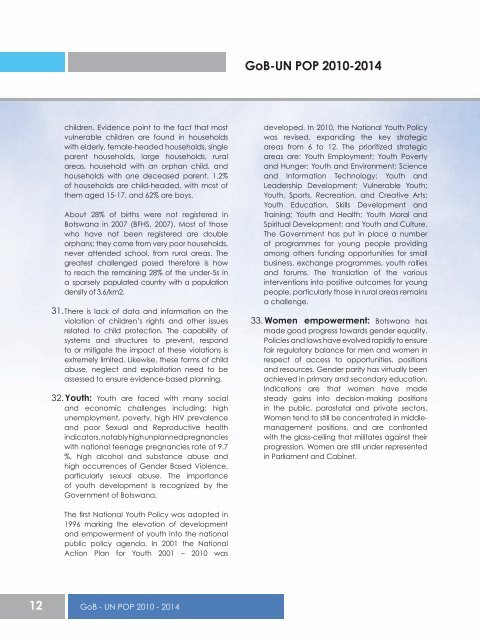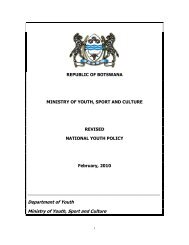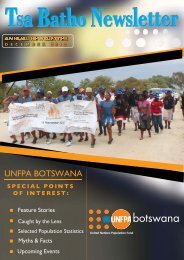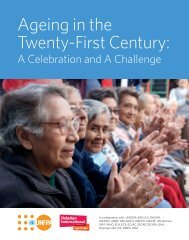GoB-UN POP 2010-2014 - UNFPA Botswana
GoB-UN POP 2010-2014 - UNFPA Botswana
GoB-UN POP 2010-2014 - UNFPA Botswana
- No tags were found...
Create successful ePaper yourself
Turn your PDF publications into a flip-book with our unique Google optimized e-Paper software.
<strong>GoB</strong>-<strong>UN</strong> <strong>POP</strong> <strong>2010</strong>-<strong>2014</strong>children. Evidence point to the fact that mostvulnerable children are found in householdswith elderly, female-headed households, singleparent households, large households, ruralareas, household with an orphan child, andhouseholds with one deceased parent. 1.2%of households are child-headed, with most ofthem aged 15-17, and 62% are boys.About 28% of births were not registered in<strong>Botswana</strong> in 2007 (BFHS, 2007). Most of thosewho have not been registered are doubleorphans; they come from very poor households,never attended school, from rural areas. Thegreatest challenged posed therefore is howto reach the remaining 28% of the under-5s ina sparsely populated country with a populationdensity of 3.6/km2.31. There is lack of data and information on theviolation of children’s rights and other issuesrelated to child protection. The capability ofsystems and structures to prevent, respondto or mitigate the impact of these violations isextremely limited. Likewise, these forms of childabuse, neglect and exploitation need to beassessed to ensure evidence-based planning.32. Youth: Youth are faced with many socialand economic challenges including: highunemployment, poverty, high HIV prevalenceand poor Sexual and Reproductive healthindicators, notably high unplanned pregnancieswith national teenage pregnancies rate of 9.7%, high alcohol and substance abuse andhigh occurrences of Gender Based Violence,particularly sexual abuse. The importanceof youth development is recognized by theGovernment of <strong>Botswana</strong>.developed. In <strong>2010</strong>, the National Youth Policywas revised, expanding the key strategicareas from 6 to 12. The prioritized strategicareas are: Youth Employment; Youth Povertyand Hunger; Youth and Environment; Scienceand Information Technology; Youth andLeadership Development; Vulnerable Youth;Youth, Sports, Recreation, and Creative Arts;Youth Education, Skills Development andTraining; Youth and Health; Youth Moral andSpiritual Development; and Youth and Culture.The Government has put in place a numberof programmes for young people providingamong others funding opportunities for smallbusiness, exchange programmes, youth ralliesand forums. The translation of the variousinterventions into positive outcomes for youngpeople, particularly those in rural areas remainsa challenge.33. Women empowerment: <strong>Botswana</strong> hasmade good progress towards gender equality.Policies and laws have evolved rapidly to ensurefair regulatory balance for men and women inrespect of access to opportunities, positionsand resources. Gender parity has virtually beenachieved in primary and secondary education.Indications are that women have madesteady gains into decision-making positionsin the public, parastatal and private sectors.Women tend to still be concentrated in middlemanagementpositions, and are confrontedwith the glass-ceiling that militates against theirprogression. Women are still under representedin Parliament and Cabinet.The first National Youth Policy was adopted in1996 marking the elevation of developmentand empowerment of youth into the nationalpublic policy agenda. In 2001 the NationalAction Plan for Youth 2001 – <strong>2010</strong> was12 <strong>GoB</strong> - <strong>UN</strong> <strong>POP</strong> <strong>2010</strong> - <strong>2014</strong>







